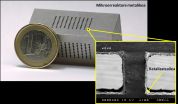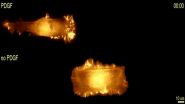(Press-News.org) For millennia, bacteria and other microbes have engaged in intense battles of chemical warfare, attempting to edge each other out of comfortable ecological niches. Doctors fight pathogens with an arsenal of weapons—antibiotics—co-opted from these microbial wars, but their efforts are frustrated by the development of drug resistance that outpaces drug discovery. Researchers at the University of Illinois at Urbana-Champaign and Northwestern University have now innovated and demonstrated the value of an algorithm to analyze microbial genomic data and speed discovery of new therapeutic drugs.
A large proportion of the medications used today were discovered by screening bacteria and other organisms for their ability to produce natural products, biologically useful compounds. In recent years, pharmaceutical companies have largely abandoned this strategy in favor of screening synthetically created chemicals for useful properties, an area of research which has yielded a tiny number of new antibiotics.
Microbiologist and molecular and cellular biologist Bill Metcalf, a leading investigator in the new study, described the reason for pharmacological research's shift away from the exploration of natural products. "There was a reason why they gave up . . . they kept discovering the same things over and over and over again," he said. "They were getting very diminishing returns."
This type of problem will be familiar to anyone who has ever collected trading cards. It's easy to acquire a set of the common cards, but it can be nearly impossible to find the rare ones scattered among them. A collector might wish that he or she could sneak a peek at all the cards hidden inside the wrappers, and only buy the new ones.
Genome sequence information, which is now available for an ever-increasing number of bacterial species, holds the promise to allow antibiotic hunters to do just that. Groups, or "clusters" of genes within each genome code for enzymes, proteins that work together to synthesize a natural product for that bacterium. Part of the vision of the Institute for Genomic Biology's Mining Microbial Genomes research group, led by Metcalf, is to use bacterial genome sequence data as an index of what products each one can produce.
If researchers could infer what type of product the bacterium is making by looking at its DNA, they wouldn't have to go through a lengthy screening process—they could just scan genomes for promising gene clusters. Unfortunately, this task is much harder than it sounds. Many clusters have some sequences or whole genes in common, making them indistinguishable by traditional comparative methods even though they enable the production of different compounds.
Metcalf, co-lead author and Institute for Genomic Biology Fellow James Doroghazi, and colleagues cleared this hurdle with a clever computational solution: they combined multiple comparative metrics, each with a carefully calibrated weight, to produce an algorithm that sorted 11,422 gene clusters from 830 bacterial genomes into an orderly, searchable reference. Their work was published this month in Nature Chemical Biology (10.1038/nchembio.1659)
In the database created in the study, gene clusters predicted to make very similar products are linked with each other in networks referred to as families. These predictions mesh almost perfectly with prior knowledge; gene clusters that produce similar known compounds were sorted by the new algorithm into the same family in every case but one.
The value of the new database was showcased by an experiment performed in collaboration with a group of chemists at Northwestern University, led by former University of Illinois faculty member Neil Kelleher. Kelleher's group used a high-precision analytical technique to infer the chemical composition of unknown compounds isolated from 178 different bacterial strains. The research team was then able to assign a biological function to gene cluster families by correlating their presence in the genome with the production of particular compounds.
In addition to this power to link gene cluster families to potential new antibiotics, the database is a huge step toward solving the "trading card" problem. By comparing the distribution of gene cluster families across bacterial species, researchers can now predict which species are most likely to contain novel antibiotics, and target the richest strains for study. "We've got the framework, we know the number of gene clusters, we know who has them and therefore we know where to look to find new drugs," said Metcalf. "It clearly leads to discovery."
INFORMATION:
In addition to Doroghazi, former Northwestern graduate student Jessica Albright was a co-first author of the study, and Neil Kelleher was a co-corresponding author. David Labeda, a microbiologist at the USDA Agricultural Research Service, shared many of the bacterial strains that provided novel genomic sequence for the work. Funding was provided by the Institute for Genomic Biology and the NIH. The database of gene cluster families is publically available: http://bit.ly/1rLR0O6.
This news release is available in Spanish.
Fuel cells are totally appropriate systems for substituting the batteries of mobile phones, laptop computers and vehicles. They turn the energy resulting from the combining of hydrogen and oxygen into electrical power, with water vapour being the only waste product. In other words, they generate energy in the same way that batteries do, but they do not contaminate.
However, if these fuel cells are to produce energy, they need an external supply of hydrogen, and right now storing hydrogen safely poses difficulties. That ...
BUFFALO, N.Y. – It is not only prenatal drug exposure, but also conditions related to drug use that can influence negative behavior in children, according to a new study from the University at Buffalo's Research Institute on Addictions.
In examining the long-term effects of cocaine use during pregnancy in a sample of low-income, cocaine-exposed and non-exposed families, researchers found that a mother's harshness toward her child during mother-child interactions at 2 years of age is one of the strongest predictors of problem behaviors in kindergarten, such as fighting, ...
A new paper from the Wildlife Conservation Society, Montana State University, Montana Department of Fish, Wildlife and Parks, and the U.S. Geological Survey looks at the feasibility of electrofishing to selectively remove invasive trout species from Montana streams as an alternative to using fish toxicants known as piscicides that effect all gill-breathing organisms.
Westslope Cutthroat Trout (WCT) have experienced severe declines throughout much of their historical range. One major reason for this decline is the current competitive advantages enjoyed by non-native Brook ...
Reducing community transmission and changing behaviour in communities is key to containing Ebola outbreaks, according to new research into the first known outbreak of the virus in 1976 by researchers at the London School of Hygiene & Tropical Medicine and Fogarty International Center at the National Institutes of Health.
The study authors include Professor Peter Piot and Dr Joel Breman, who travelled to Zaire (now the Democratic Republic of Congo), to investigate the first outbreak in 1976. The study, published in Epidemics, also found that if the people in the affected ...
By studying identical twins, researchers from Lund University in Sweden have identified mechanisms that could be behind the development of type 2 diabetes. This may explain cases where one identical twin develops type 2 diabetes while the other remains healthy.
The study involved 14 pairs of identical twins in Sweden and Denmark. One twin had type 2 diabetes and the other was healthy.
"Twins are a good model for finding mechanisms, but the results are applicable to all", said Emma Nilsson, who carried out the study with Charlotte Ling.
We know that fat tissue can ...
Worldwide there have been 71 documented cases of patients with anaplastic large cell lymphoma (ALCL) in which researchers suspected breast implants to be the cause. ALCL is normally found in the lymph nodes, as well as in skin, lung, liver and soft tissue, but not usually in the breast. Cases in which ALCL developed in the breast region almost exclusively involved patients who have had breast surgery. In these cases, ALCL developed around ten years after the operation. The tumours grew in the scar tissue around the implant.
Breast implants are generally safe and studies ...
New theoretical physics models could help us better grasp the atmospheric chemistry of ozone depletion. Indeed, understanding photoabsorption of nitrous oxide (N2O) — a process which involves the transfer of the energy of a photon to the molecule — matters because a small fraction of N2O reacts with oxygen atoms in the stratosphere to produce among others nitric oxide (NO). The latter participates in the catalytic destruction of ozone (O3). Now, new theoretical work unveils the actual dynamic of the photoabsorption of nitrous oxide molecules. These findings by Mohammad ...
VIDEO:
The cell stimulated with the growth factor PDGF (upper cell) migrates targeted in only one direction on its track, while the not stimulated cell (lower cell) changes its direction of...
Click here for more information.
During cancer metastasis, immune response or the development of organisms, cells are moving in a controlled manner through the body. Researchers from the Department of Biomedicine at the University of Basel discovered novel mechanisms of cell migration by ...
Viruses can convert their DNA from solid to fluid form, which explains how viruses manage to eject DNA into the cells of their victims. This has been shown in two new studies carried out by Lund University in Sweden.
Both research studies are about the same discovery made for two different viruses, namely that viruses can convert their DNA to liquid form at the moment of infection. Thanks to this conversion, the virus can more easily transfer its DNA into the cells of its victim, which thus become infected. One of the studies investigated the herpes virus, which infects ...
This news release is available in German.
How can a beam of light tell the difference between left and right? At the Vienna University of Technology (TU Wien) tiny particles have been coupled to a glass fibre. The particles emit light into the fibre in such a way that it does not travel in both directions, as one would expect. Instead, the light can be directed either to the left or to the right. This has become possible by employing a remarkable physical effect – the spin-orbit coupling of light. This new kind of optical switch has the potential to revolutionize ...



